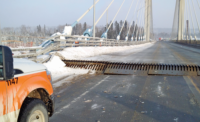Ontario transportation officials have made some initial findings on what triggered the deck split and nearly 2-ft upward displacement on one span of the province’s first cable-stayed bridge. Preliminary observations made by engineers investigating the incident, which has limited traffic on the Nipigon River Bridge, about 60 miles from Thunder Bay, indicate a “possible tension-type failure” of bolts securing the bridge deck to its framing, according to a spokesman for the province’s Ministry of Transportation.
The breach involved the west span of the new, $106-million bridge, which went into service on Nov. 29. Following the deck split on Jan. 10, transportation ministry officials said 40 bolts securing the deck to beams on the west span of the crossing failed under uplift forces from the bridge cables.
The breach in the roadway temporarily halted traffic on the heavily used Trans-Canada Highway. No motorists sustained injuries, and the deck has since been loaded with highway dividers to close the gap, with traffic allowed over a single lane.
Tests of the bolts are being carried out at the National Research Council of Canada, in Ottawa, and Surface Science Western, at Western University.
Different Span Lengths
Designed by Toronto-based MMM Group, the structure was Ontario’s first cable-stayed bridge. The 252-meter-long structure has spans of 113 and 139 meters.
According to a description of the bridge deck on a website of Hatch Mott MacDonald, which served as construction contract administrator, the deck comprises steel beams and three plate girders, with a series of transverse beams supporting the precast-concrete deck.
The exact design of the connections involved is unclear. Gerry Chaput, assistant deputy minister in Ontario’s Ministry of Transportation, said the bolts suspected of failing were resisting uplift forces on the shorter west span.
Steven Del Duca, Ontario’s Minister of Transportation, on Jan. 19 issued a statement that the bridge had been designed to meet all Canadian codes and that “tensioning of the cables has been confirmed.” However, the ministry has said it has not yet ruled out other factors in its investigation. It is too early to say whether the construction, design and engineering team will face any penalties for the issues with the bridge, he said.
Bot Ferrovial, the joint venture that built the current bridge spans, is building another bridge, alongside the new structure, to carry traffic in the opposite direction. The venture combines Bot Construction, one of Canada’s largest civil engineering and construction companies, with Ferovial Agroman Canada, part of Madrid-based, global infrastructure giant Ferovial.
The split in the bridge immediately stoked speculation in the local media that the severe Canadian cold was to blame. But the temperature, while cold, was well within the range for which the bridge was designed.
An engineer, speaking on the condition that he not be identified, who has worked on cable-stayed bridges in Canada said it is highly unusual for a new cable-stayed bridge to be experiencing a major issue.
“You can definitely say it’s unusual and undesirable, for sure,” the engineer remarked. He added that dealing with uplift force is a common issue with cable-stayed bridges and that one span is typically longer than the other.
The engineer said the problem is likely to extend beyond the bolts to the sliding uplift bearing on the shorter, western deck of the bridge, which was designed to deal with the uplift force exerted by the longer, eastern deck.
“I think that, ultimately, they will find there have been issues with the details of the uplift bearing,” he said.
An incorrect temperature for the region around the bridge appeared in the original version of this story and was deleted Feb. 1.




Post a comment to this article
Report Abusive Comment